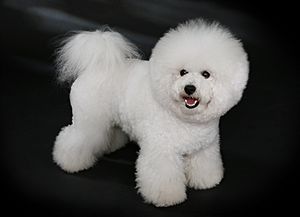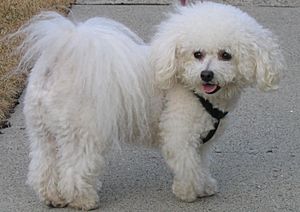Bichon Frisé facts for kids
A Bichon Frise is a small, fluffy dog breed. They have a soft coat that is usually white, but can also be light apricot or gray. Most people prefer a pure white coat, especially for dog shows. Bichon Frises are known for being very playful and friendly dogs.
Contents
History of the Bichon Frise
Where Did Bichons Come From?
The Bichon Frise might seem like a French dog, but its ancestors actually came from Spain! These dogs were first used by sailors. When the French discovered them, these gentle dogs became popular as lap dogs for royalty.
There were four main types of Bichon dogs: the Maltese, the Bolognese, the Havanese, and the Bichon Tenerife (which is the Bichon Frise we know today). All these breeds started in the Mediterranean area.
Traveling Dogs and Royal Pets
Because they were so happy and friendly, Bichons traveled a lot. Sailors often used them to trade with people as they sailed between countries. The dogs became popular in Spain, and it's thought that Spanish sailors brought them to the Canary Islands, especially Tenerife.
Later, in the 14th century, Italian sailors found these little dogs and brought them back to Italy. They quickly became favorites of the Italian noble families. Back then, it was common to trim their fur to look like a lion's mane, similar to how some Portuguese Water Dogs are groomed today.
Even though they were sailor's dogs, Bichons were mostly companions. They loved being with people.
Bichons in France and Spain
The "Tenerife" Bichon became very popular in France during the Renaissance, especially with kings like Francis I and Henry III. They were also loved by Spanish princesses, and famous Spanish painters, like Francisco de Goya, even included Bichons in their paintings!
Their popularity faded for a while, but then came back during the time of Napoleon III. After that, they became more common dogs. You might have seen them with organ grinders on the streets, helping the blind, or performing tricks in circuses and fairs.
Official Recognition of the Breed
In France, on March 5, 1933, the official rules for the Bichon Frise breed were set. This happened partly because of the popular comic book character, Snowy (Milou in French), a small white dog from The Adventures of Tintin.
Since the breed had two names, "Tenerife" and "Bichon," the head of the international dog club suggested calling them "Bichon Frisé." "Frisé" means "curly" in French, which perfectly describes their coat! On October 18, 1934, the Bichon Frise was officially added to the French dog registry.
Bichons Come to America and Australia
The first Bichons arrived in the United States in 1955. The breed slowly grew in popularity there. In 1973, the Bichon Frise was allowed to compete in major dog shows in the US. A Bichon Frise named JR even won "best-in-show" at the famous Westminster Kennel Club Dog Show in 2001!
In Australia, the first Bichon was brought over in 1976, and the first litter of puppies was born there in 1977.
What Does a Bichon Frise Look Like?
Appearance of a Bichon Frise
The Bichon Frise is a small dog. They usually weigh about 5–10 kilograms (10–20 pounds) and stand 23–30 centimeters (9–12 inches) tall at the shoulder. Their head is slightly rounded, and their nose is black. They have dark, round eyes that look very sweet.
Their tail is usually long and curly, carried over their back. The most famous part of a Bichon is its coat! It's curly, thick, and mostly white. They don't shed much, similar to a poodle. Sometimes, you might see a little bit of cream, buff, or apricot color around their ears, snout, or paws, but pure white is preferred for dog shows. Their ears and tail are natural, not cut or changed. Their fur is often trimmed to keep it looking neat and even. Bichon Frises are also known for being quite smart!
Bichon Frise Personality
The American Kennel Club describes the Bichon Frise as "merry" and "cheerful." They are known for being gentle, sensitive, playful, and loving. Bichons absolutely love being with people and need a lot of attention. They are usually very friendly and enjoy going out with their owners. They are charming, loving, and intelligent dogs.
Bichons get along well with children because they are playful and have lots of energy. Since they were bred to be companion dogs, they usually get along well with other pets too. If you start training them early and keep it up, Bichon Frises are very obedient.
Common Health Issues
Bichon Frises can sometimes scratch or chew their skin, which can lead to skin problems. They are considered hypoallergenic, meaning they are less likely to cause allergies in people. However, they can have allergies themselves, like to fleas, pollen, or dust. Other common health issues for Bichons include loose knee joints, ear infections, cataracts (eye problems), diabetes, and heart disease.
Do Bichon Frises Shed?
Bichon Frises are often on lists of dogs that don't shed much. This is because their curly coat helps to trap loose hair and dander (tiny flakes of skin) instead of letting it fall everywhere. Regular grooming, like brushing and bathing, helps remove this trapped hair and dander, which also helps control allergens.
It's a good idea to have a Bichon Frise groomed every four to eight weeks. Daily brushing is important to stop their fur from getting tangled and matted. If their coat gets very matted, they can develop painful lumps, especially in their ears.
Even though they are called "hypoallergenic," it's important to remember that people's allergies to dogs can be different. While Bichons produce fewer allergens, they still have some, and these can stick to clothes, carpets, and furniture.
How Long Do Bichon Frises Live?
Bichon Frises usually live for about 12 to 13 years or even longer. This is similar to other dog breeds of their size and a bit longer than many purebred dogs in general. Some Bichons have even lived to be 16 or 19 years old!
Images for kids
See also
 In Spanish: Bichón frisé para niños
In Spanish: Bichón frisé para niños










